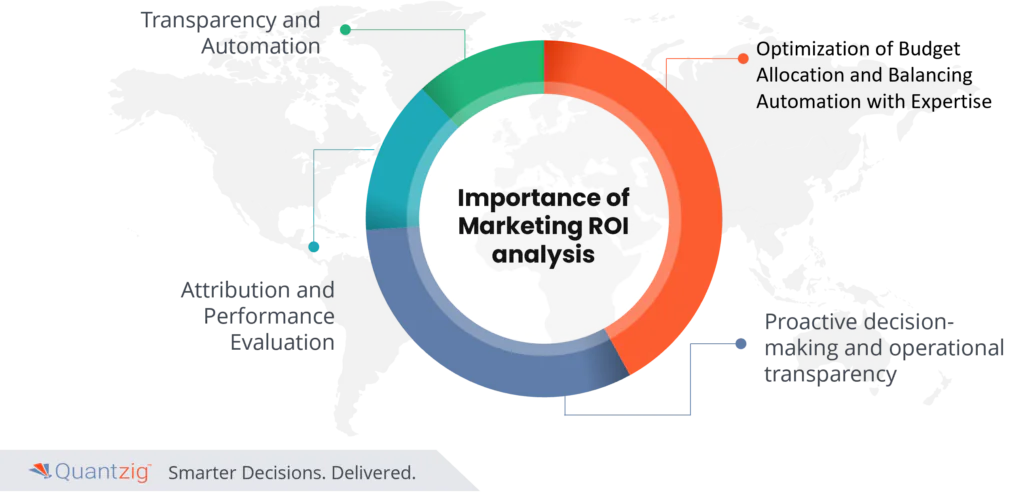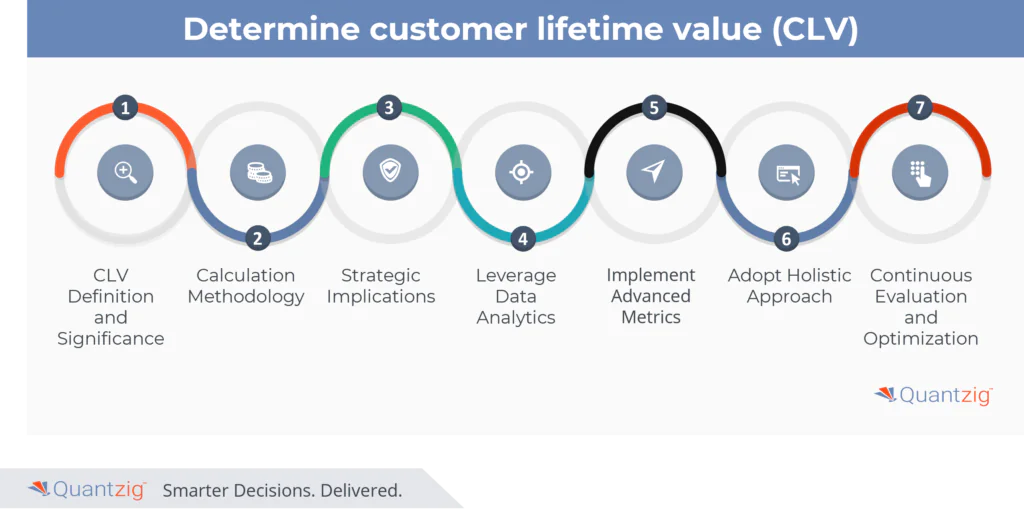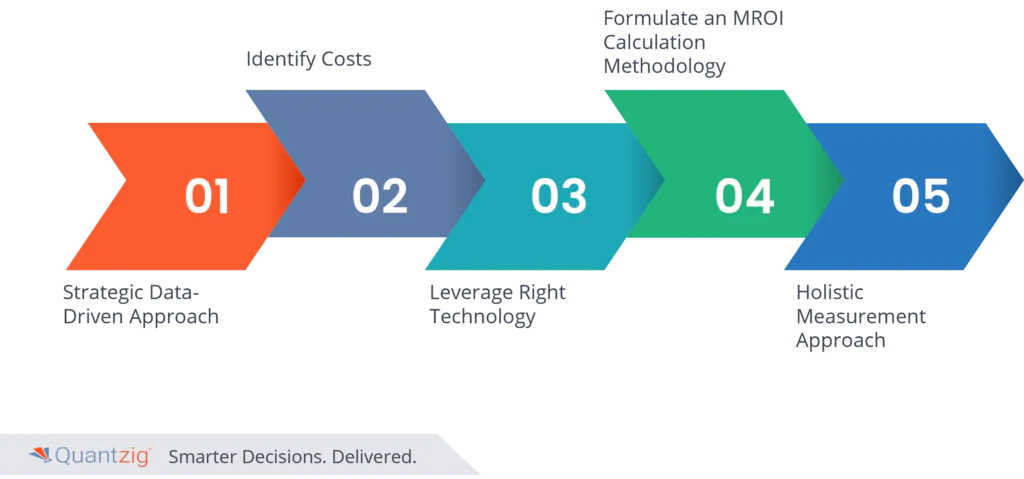Written By: Sudeshna Ghosh
Table of Contents
Introduction to Marketing ROI Analysis
The financial return your company receives from all its marketing initiatives is known as marketing return on investment, or MROI. It includes the overall profit and growth in revenue from various marketing channels, such as social media, email, and digital marketing, among others.
As evidenced by the Quantzig Experts, enhancing marketing ROI and attribution consistently emerges as a paramount objective for marketers worldwide. From integrating channel specific MROI to evaluating overall MROI, precise measurement not only substantiates the efficacy of marketing efforts but also facilitates compelling demonstrations of their effectiveness.
Book a Marketing ROI Analysis demo to experience the meaningful insights we derive from data through our analytical tools and platform capabilities. Schedule a demo today!
Request a Free DemoQuantzig’s Expert Solutions
Quantzig’s advanced MDM framework offers a comprehensive solution tailored to precisely quantify the impact of your marketing activities. Our innovative approach allows for the layering of results across multiple brands, enabling a nuanced understanding of performance. Leveraging advanced simulation tools, we facilitate the virtual measurement of returns and empower clients to optimize their media plans effectively. At the core of our Unified Marketing Decision Management lies a holistic approach to measurement and attribution. Through the implementation of a laddered stage attribution model, we meticulously isolate the diverse impacts of commercial activities on volume, thereby capturing synergistic effects with unparalleled accuracy.
Our methodology further enhances incremental revenue growth, delineating contributions from pricing strategies, promotions, marketing initiatives, and ancillary factors such as pantry loading and sales execution corrections. Employing a laddered mode of marketing impact measurement, combining top-down and bottom-up analyses, we deliver actionable insights into commercial dynamics, digital attributions, and consumer behavioral influences. Moreover, our planning simulators furnish clients with invaluable capabilities to dissect revenue breakdowns, discerning controllable and non-controllable factors, and ultimately, optimizing ROI across every channel.
Why should a client opt for our offering?
Clients should opt for our offering due to its unparalleled ability to adapt to the dynamic and fast-moving nature of data in today’s marketing landscape. We have meticulously designed our solutions to accommodate the continuous flow of information, ensuring that marketing teams can make more informed and timely decisions with recency factored in. Moreover, our solutions are highly customizable to suit the specific needs and preferences of our clients. Whether it’s a leadership cockpit dashboard for executives, a DIY workbench tailored for marketing analysts, or seamless integration with existing CRM and marketing systems, we provide versatile solutions that align with diverse organizational requirements. By choosing our offering, clients gain access to a robust framework that not only leverages real-time data but also empowers teams to optimize decision-making processes and drive superior marketing performance.
Experience the advantages firsthand by testing a customized complimentary pilot designed to address your specific requirements. Pilot studies are non-committal in nature.
Request a Free PilotWhat is ROI in Marketing: An Overview
Return on investment (ROI) is used to quantify how marketing programs and campaigns generate revenue for the business. ROI measures the money your company spends on marketing campaigns in comparison to the revenue those campaigns produce.
Marketing ROI is important because it provides a thorough insight into marketing performance and how it affects business results. This invaluable insight gives companies a competitive edge by facilitating informed decision-making and strategic adjustments.
Businesses can obtain invaluable insights into the effectiveness and profitability of various marketing channels by utilizing MROI data. Equipped with this understanding, they may redirect resources to the most productive paths, optimizing their target audience’s reach and interaction.
It is highly important for small and midsize businesses (SMBs) to identify and use the best marketing strategies quickly. SMBs should carefully devote their limited budgets and resources to projects that will pay off. In this sense, MROI acts as an indicator of guidance that helps small and medium-sized businesses (SMBs) maximize their marketing efforts.
It has been found that MROI analysis empowers organizational marketing teams to enhance the value of their marketing strategies to organizational leadership. By presenting concrete evidence of campaign success and the resulting business impact, marketers can justify continued investment in marketing technology and initiatives. This advocacy is especially crucial for SMBs, where financial resources for technology adoption may be limited.
In essence, MROI measurement is not only useful to enhance marketing effectiveness but also it facilitates alignment between overarching business objectives and marketing efforts. It is a cornerstone of data-driven business decision-making as it enables businesses to navigate the complex dynamic landscape of modern marketing with precision and confidence.
What is the Importance of Marketing ROI analysis for Your Business?

The importance of Marketing ROI analysis for your business cannot be overstated. It serves as the cornerstone for informed decision-making and strategic allocation of resources. Here’s why it’s crucial:
- Integrated Data Management: This necessitates a unified and integrated management system that can bring together separate data sources, which are often fragmented in silos, such as agency-based data. By centralizing data, companies can gain complete understandings into marketing results across different platforms.
- Attribution and Performance Evaluation: Proper Marketing ROI analysis permits companies to attribute causality and evaluate performance against investments. This involves pinpointing which marketing efforts contribute most significantly to revenue creation and overall business expansion, thereby guiding optimization strategies and resource allocation.
- Optimization of Budget Allocation: Using insights derived from analyzing marketing ROI, businesses can optimize how they do their budget allocation across marketing channels. By identifying which channels drive the highest returns on investment, companies can strategically direct resources to maximize marketing success.
- Transparency and Automation: Marketing automation and analytics tools are critical for enabling transparent, streamlined ROI analysis. These solutions must be carefully designed to ensure transparency, especially in digital attribution, avoiding any “black box” effects. Further, automation simplifies the analysis process, reducing manual work and speeding up decision-making.
- Balancing Automation with Expertise: While automation is essential for efficiency, it’s equally crucial to preserve room for expert insights and decisions. These solutions should be designed to provide actionable insights while allowing for expert interpretation. This balance ensures that organizations leverage the advantages of automation while capitalizing on the expertise of marketing professionals.
To succeed in the highly competitive business environment of today, companies must adopt creative data-driven approaches. Performing comprehensive competitive research lets firms pinpoint their advantages and disadvantages compared to rivals. Examining return on investment for offline marketing together with other marketing expenditures gives organizations insight into how well their marketing efforts are working. Looking at organic sales increases and historical performance numbers like monthly averages and conversion rate helps optimize spending on marketing.
Moreover, leveraging auto-investments and monitoring the global crypto market can enhance returns and mitigate risks. Calculating the cost per acquisition (CPA) ratio facilitates efficient allocation of resources, while implementing an enterprise revenue performance management strategy ensures sustainable growth and profitability. In summary, this technique provides an in-depth systematic framework for driving long-term business success and evaluating marketing effectiveness.
At its core, Marketing ROI analysis is vital for enterprises looking to enhance their marketing strategies, boost performance, and enable sustainable growth. By integrating advanced analytics, integrated data management, and automation solutions, companies can unlock new paths to success in the present dynamic and competitive market.
Understanding Customer Lifetime Value (CLV) for Marketing ROI

Customer Lifetime Value (CLV) is an essential measurement that enables all the companies to assess the long-term value of their customer relationships. Understanding CLV allows businesses to make well-informed decisions about retaining existing ones, acquiring new customers, and overall business plans. The following four essential aspects explain the significance of calculating CLV and how to work it out:
1. CLV Definition and Significance:
CLV refers to the total income any business can expect from a customer over their relationship. It considers the initial transaction and subsequent purchases and engagement as time passes. This metric provides critical insights into the financial value of individual customers, allows businesses to prioritize resources, optimize marketing spend, and customize their marketing efforts. This technique guides customer-focused strategies by helping build long-lasting relationships and identify high-value customers.
2. Calculation Methodology:
Calculating CLV involves a complex formula accounting for factors like purchase frequency, customer lifespan, average order value, and retention rate. The basic formula multiplies average order value by purchase frequency, then multiplies that result by the average lifespan. Additionally, adjusting for things like customer acquisition costs and discount rates can produce a more precise CLV. Using advanced analytics tools and data-driven methods can streamline this, letting businesses derive accurate CLV figures tailored to their unique customer base.
3. Strategic Implications:
With knowledge of customer lifetime value (CLV), companies can create focused plans to improve customer relationships and increase long-term profitability. By recognizing high CLV groups, businesses can direct resources to customer acquisition and retention efforts that produce the greatest returns. In addition, CLV review supports customized marketing attempts, as organizations can adapt their messaging and offerings to connect with the preferences and actions of high-value buyers. Furthermore, CLV acts as a key measurement for evaluating the effectiveness of marketing promotions and customer engagement initiatives, allowing continuous enhancement and refinement of tactics.
4. Leverage Data Analytics:
Utilize web analytics and comprehensive customer relationship management (CRM) systems to obtain relevant customer engagement data across numerous online channels such as website interactions, newsletters, and social media. By continuously tracking purchase behaviors, and engagement duration, you can effectively calculate customer lifetime value (CLV). This involves analyzing indirect revenue attribution and direct revenue attribution, ensuring accurate assessment of repeat purchase rates and average order values to ascertain the long-term profitability of acquired customers.
5. Implement Advanced Metrics:
Leverage advanced marketing analytics platforms with cross-channel analysis capabilities to integrate data from various touchpoints including native ads, display ads, and offline channels like sponsorship events or NASCAR vehicles. By examining efficiency ratios and cost ratios, engagement duration, customer acquisition costs, internal expenses, and advertising expenses, you gain insight into overall return on investment (ROI) to determine customer lifetime value (CLV).
6. Adopt Holistic Approach:
Adopt a holistic perspective by incorporating quantitative and qualitative factors to evaluate brand awareness, customer loyalty, and loyalty. Use social media metrics like social media likes, mentions, and content output to gauge brand engagement and customer sentiment. Also, integrate sales staff feedback and customer feedback from channels like check-in emails to enrich understanding of satisfaction and improve CLV assessment accuracy.
7. Continuous Evaluation and Optimization:
Customer Lifetime Value is a static metric that requires ongoing evaluation and optimization. Businesses should regularly monitor shifts in customer behavior, market dynamics, and competitive landscape to refine their CLV computations and approaches. Furthermore, leveraging predictive analytics and machine learning can forecast future CLV patterns, enabling proactive choices and preventative actions to nurture customer relationships and sustain growth.
In summary, Customer Lifetime Value encapsulates the essence of customer-centricity and long-term business endurance. By comprehending and harnessing CLV, companies can uncover new growth opportunities, build lasting customer relationships, and thrive in an increasingly competitive market. Adopting CLV as a guiding metric empowers businesses to navigate the complex modern business landscape with confidence and accuracy, driving value creation and sustainable success.
How is Marketing ROI Used by Companies?
Marketing return on investment (ROI) is an essential metric used by many organizations across various industries, including the global cryptocurrency market, to recognize the effectiveness of their marketing initiatives. By reviewing ROI alongside key performance indicators such as conversions, marketing programs, and marketing leads, companies can evaluate how their marketing campaigns influence sales cycle days and cost ratio. This allows them to optimize resource distribution and enhance the efficiency ratio of their marketing tactics. Furthermore, platforms like Binance Tools give useful understandings into trade records and price graphs, enabling traders and investors to make informed choices. Through strategic use of marketing ROI data, companies can drive growth, improve customer acquisition, and promote long-lasting success in an ever-changing market.
It is a significant tool for companies to evaluate efficiency and the success of their marketing efforts across various initiatives and channels. By utilizing indirect revenue attribution and direct revenue attribution, companies can measure how their marketing impacts organizational profitability accurately. Strategic keyword bidding and content creation help companies optimize their online presence and attract relevant traffic, while event sponsorships and informed purchasing contribute to brand awareness and customer engagement.
Marketing ROI is an essential metric that organizations use to ensure optimal allocation of resources and analyze the effectiveness of their marketing investments. By analyzing simple marketing ROI from various marketing initiatives such as events, content, and marketing newsletter articles, companies can assess performance against revenue objectives and organizational growth targets. However, challenges such as the complexities of calculating marketing ROI and tracking downloads hinder the process. Nonetheless, leveraging marketing ROI at the organizational level enables companies to increase marketing dollars and make informed decisions regarding their marketing budget allocation and drive sustainable growth.
Through marketing investments in cross-channel analysis and platforms like Twitter, websites, and newsletters, companies can track and analyze customer behaviors and interactions to make better decisions. Using robust marketing automation enables companies to streamline processes, nurture leads, reduce customer acquisition costs, and enhance promotions and loyalty programs to increase average order value and repeat purchases. Analyzing purchase costs and monitoring competitors further refines marketing tactics, while loyalty programs and follow-up emails build long-term customer relationships and loyalty.
How to Measure Marketing ROI?

Many enterprises encounter challenges when attempting to quantify the return on investment (ROI) of their marketing endeavors. These difficulties often stem from disarrayed marketing data, ambiguous connections between customer actions and short-term results, or a focus on tracking inconsequential metrics. To surmount these obstacles, the initial step entails devising a comprehensive strategy for measuring MROI.
Key constituents of any adept marketing measurement strategy encompass:
- Strategic Data-Driven Approach for Marketing ROI Optimization: Implementing innovative data-driven strategies is highly essential for promoting sustainable revenue growth and maximizing return on investment (ROI). By examining the competition and marketing efforts, businesses can refine their budget allocation to prioritize high-impact initiatives. Leveraging a robust marketing analytics platform provides insights into customer lifetime value (CLV), marketing costs, and conversion rates, enabling data-driven business decisions. Integrating direct and indirect revenue attribution allows organizations to accurately evaluate the effectiveness of marketing programs, enhancing cost per acquisition (CPA) ratios and revenue performance strategies.
- Identifying Costs: Understand and document all marketing spend related to your marketing efforts, ensuring both accuracy and transparency in marketing cost evaluation.
- Leveraging Right Technology: Integrating accurate technological tools is vital for efficient data collection, data analysis, and data interpretation, facilitating data-driven decision-making processes.
- Formulating an MROI Calculation Methodology: Develop a structured formula for computing MROI, such as MROI = (Marketing Value − Marketing Cost) / Marketing Cost. This standardized formula is universally applicable across various campaigns and channels, sales cycle days, albeit more complex approaches to MROI computation may also be considered.
- Holistic Measurement Approach for Marketing ROI Evaluation: Effective MROI measurement entails a comprehensive analysis encompassing various metrics such as offline MROI, organic sales growth, and historical monthly averages. By scrutinizing auto-investments and monitoring trends in the global crypto market, businesses can adapt their strategies for optimal marketing cost management. Integrating valuable insights from customer lifetime value (CLV) calculations allows personalized marketing programs, enhances customer acquisition and retention efforts. This holistic approach ensures accurate ROI assessment, facilitates continuous optimization of marketing efforts to achieve sustainable revenue growth.
While the foundational formula remains consistent, it’s crucial to tailor the measurement approach to align with the unique dynamics of your business. Utilizing an ROI calculator can serve as an invaluable starting point in this endeavor.
Furthermore, it’s imperative to recognize that MROI need not exclusively revolve around financial metrics. Integrating softer indicators like social media engagement metrics (e.g., likes, followers) into the evaluation framework enriches the analysis, providing a more holistic perspective on marketing performance.
Ultimately, the essence of MROI calculation lies in optimizing customer engagement consistently. By discerning the efficacy of messaging and channels through robust numerical analysis, businesses can refine their data-driven strategies, personalize customer journeys, and foster enduring client relationships. This data-driven approach not only enhances marketing efficiency but also cultivates sustained customer satisfaction and loyalty.
What are the Challenges of Calculating Marketing ROI?
Calculating MROI involves navigating numerous challenges within the complex marketing landscape. One potential hurdle lies in proper marketing measurements, particularly in assessing the impact of omnichannel campaigns across various marketing touchpoints. Besides, choosing the right attribution models is essential amidst diverse industry factors that influence consumer behavior and needs. Ensuring the reliability of marketing analytics platform data is required for precise ROI calculations because it factors in elements like agency fees and internal expenses incurred during media buys.
Misattribution also remains a significant challenge, especially in assessing the impact of online media on broad reach campaigns. Besides, waste in advertising compounds the issue, necessitating precise attribution models within the marketing technology platform. It has been found that ensuring alignment with business lines and product lines is pivotal for accurate ROI assessment, focusing the significance of robust Marketing Evolution Platform integration to optimize performance and mitigate discrepancies.
Conducting monthly comparisons also can be challenging due to seasonal variations and fluctuating trends, while grappling with negative sales growth requires an innovative strategic approach to mitigate significant losses. Evaluating the effectiveness of marketing agencies and initiatives such as content output rate and social media likes, introduces complexities stemming from intangible metrics and varying success indicators. Managing hybrid campaigns and sales cycle days demand a nuanced attribution model to accurately measure impact across multiple channels. Implementing a qualifying filter and tracking metrics like email leads, engagement duration, and paid sales are imperative for precise ROI assessment. Understanding the target market and navigating competitive fees, particularly in sectors like crypto-asset exchanges, further complicates ROI calculations, highlighting the need for robust analytics and strategic decision-making.
What the future holds?
- The future of MROI analysis entails advanced analytics and AI integration, enabling businesses to uncover deeper insights and optimize data-driven strategies with precision. Predictive modeling and forecasting will play a pivotal role, facilitating proactive adjustments based on anticipated trends.
- Cross-channel attribution will become more important, as it allows businesses to accurately gauge the influence of each customer’s touchpoints and accordingly guide budget distribution across channels.
- As the business landscape evolves, data-driven approaches will continue to lead decision-making. With progress in technology, competitive analysis will become more refined, helping companies gain a deeper understanding of their standing in the market. Calculating return on investment for offline marketing efforts, together with closely monitoring marketing expenditures, will stay crucial for optimizing how budgets are allocated.
- Predictive analytics will play a crucial role in forecasting organic sales growth, optimizing sales price, and analyzing historical monthly averages to anticipate future trends. Enhanced understanding of conversion rate dynamics will drive targeted marketing efforts. Embracing auto-investments and leveraging insights from the global crypto market will offer new avenues for revenue generation.
- The cost per acquisition (CPA) ratio will continue to guide resource allocation strategies. Embracing an integrated enterprise revenue performance management strategy will be essential for sustained growth and competitiveness in the market. Overall, the future of marketing ROI analysis holds immense potential for businesses to drive innovation, efficiency, and profitability.
- Moreover, a heightened focus on personalization and customer-centricity will drive increased engagement and loyalty, further enhancing ROI. In essence, innovation and data-driven decision-making will shape the future of MROI analysis, empowering businesses to thrive in an evolving marketing landscape.
Get started with your complimentary trial today and delve into our platform without any obligations. Explore our wide range of customized, consumption driven analytical solutions services built across the analytical maturity levels.
Start your Free Trial Today


